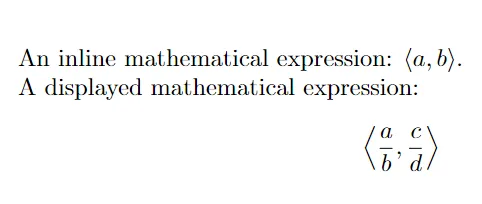How to Write Angle Brackets <> in LaTeX
In LaTeX, you can write angle brackets using the \langle and \rangle commands for mathematical expressions. These commands are part of the core LaTeX distribution and do not require any additional packages.
The following examples show how to write angle brackets in LaTeX.
How to Write Angle Brackets in Text
We can directly use angle brackets in a LaTeX document for text.
Example: Angle Brackets in Text
Suppose we want to write angle brackets in the text.
We can use the following LaTeX code to do so:
\documentclass{article}
\begin{document}
This is an example of using angle brackets <like this> in a sentence.
\end{document}
Output: 👇️
This is an example of using angle brackets <like this> in a sentence.
In this example, we use the angle brackets to enclose a part of the sentence.
How to Write Angle Brackets in Mathematical Expressions
For mathematical expressions, we can use the \langle and \rangle commands to ensure proper formatting.
Example: Angle Brackets in Mathematical Expressions
Suppose we would like to write mathematical expressions that contain angle brackets.
We can use the following LaTeX code to do so:
\documentclass{article}
\begin{document}
An inline mathematical expression: \( \langle a, b \rangle \).
A displayed mathematical expression:
\[
\left\langle \frac{a}{b}, \frac{c}{d} \right\rangle
\]
\end{document}
Output: 👇️

In this example, we use the \langle and \rangle commands are used to enclose elements in a vector or set. The \left\langle and \right\rangle commands are used to adjust the size of the angle brackets to fit the enclosed fractions.
Conclusion
We can use the standard keyboard characters < and >. For mathematical expressions, the \langle and \rangle commands ensure proper formatting.
For larger expressions, the \left\langle and \right\rangle commands help in adjusting the size of the angle brackets automatically.